As an Amazon Associate I earn from qualifying purchases.
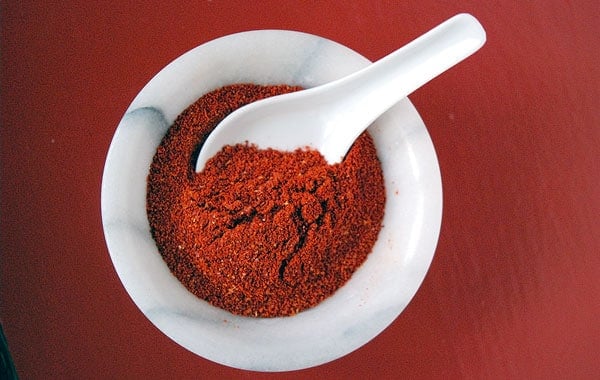
Why bother making homemade paprika? Fair question. After all, the Spanish and Hungarians are better at it than we ever will be, right?
Why not just call up Penzey’s or somesuch and order some? Well, I do. But making something like paprika at home is not so much something I did out of necessity as it was an exercise in whether I could do it at all.
It’s not that I think the world is about to collapse and oh-where-oh-where will I get the paprika to make my chorizo or chili or goulash, not to mention deviled eggs? It’s that I have a fascination with how things are made; I am a sucker for those shows on Discovery Channel or NatGeo.
So I asked myself: “What would it take to make enough paprika for our household use for one year?” And just how do you make paprika?
Turns out making paprika is easy, but it takes a while. You basically need to start paprika long before you want the powder by growing the right kind of peppers. Almas or boldog peppers are standard: They’re vivid red peppers that aren’t too thick; bell peppers are not ideal. Why? Thick-walled peppers tend to rot when left to dry, although you can certainly use a dehydrator to prevent rot if all you have are ye olde bell peppers.
The reason paprika peppers are so special is because they have character. They are neither too sweet or too spicy. No matter what pepper you use, you want something in between. I find that poblanos, left to fully ripen, are another excellent substitute, but very different.
Here is a primer on all things paprika, if you want to go down that rabbit hole.
For my paprika experiment, I planted three Alma Paprika Pepper plants, and at the end of the season I had several strings of peppers hanging in our garage.
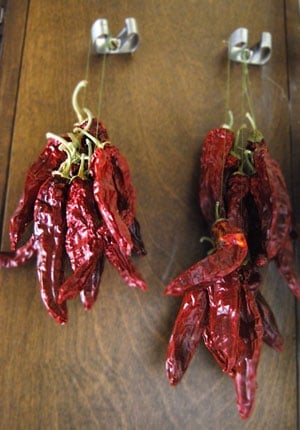
This first thing about making paprika I learned as I broke them into smaller bits to grind was this: Chiles need to be dried in arid, hot shade. Drying in the sun bleaches away color. Excess heat, like you’d get in an oven, adds an almost cooked aroma to the chiles.
And in all cases, humidity is the enemy. I dried a couple peppers in the (more humid, cooler) house and when I opened them up they were all fuzzy inside. Mold. I tossed them. None of the peppers in the garage had mold. (I live in Sacramento, California, where it is very hot and dry in the summer.)
Making the powder is pretty easy. Break the peppers into pieces small enough to jam into a spice grinder. I discard the seeds, because including seeds dilutes color and can increase the heat if you’re using hotter chiles. The grinding takes a few steps, because you always get a a few pieces that don’t want to grind. Keep sifting the bits through a fine-mesh sieve until you get an even powder.
That’s all there is to it.
In that first experiment, I wound up with 10 tablespoons of paprika from the peppers you see hanging in the picture. Definitely not enough for a year, but maybe for a few months — unless I wanted to make a huge batch of chorizo or Italian hot sausage. Given all this, I reckon I’d need 10 to 15 plants to supply me for a year.
The cool thing about this experiment is that 10 to 15 plants is actually a reasonable number in my garden, if I so chose to devote that much space to paprika. And since I am decent enough at growing chiles from seed, I could have a perpetual supply for nothing.
What’s more, my homemade paprika tastes just as good or better than the expensive kind I buy from Penzey’s. That was something of a surprise — and confirmation that there is no great mystery to making this spice. (Spanish smoked paprika is quite another thing.)
But still. Was it all worth it? The planting and the hanging and the months’ worth of waiting? Sure, if you have space and time. Grinding your own paprika is satisfying, and you get some really, really good spice out of it.
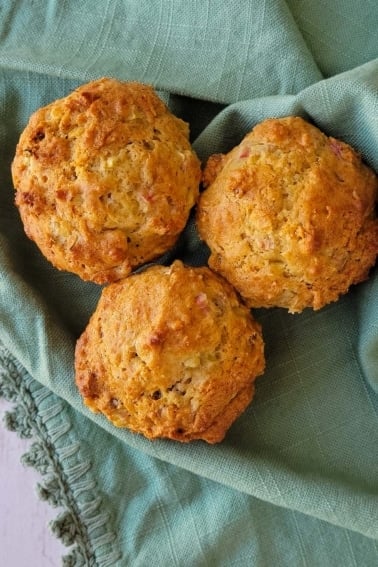

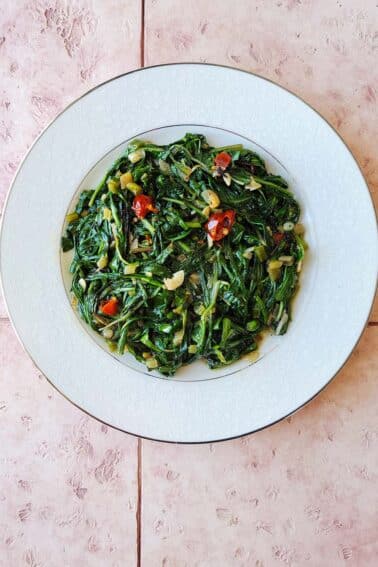
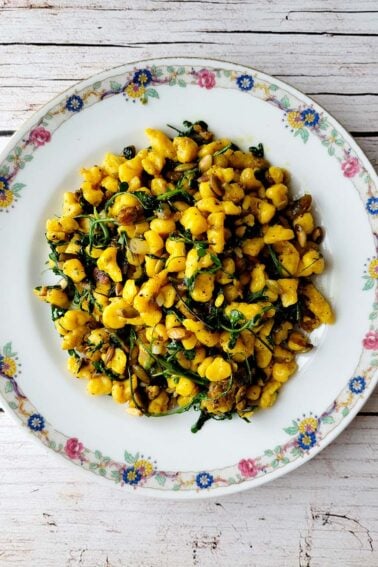
“Alma” is the Hungarian word for “apple.” The true alma pepper is a round pepper. Also, “paprika” is the Hungarian word for “pepper.”
I’ve been making my own paprika for years. I don’t use alma peppers. Mine are like Boldog. People tell me it tastes better than store-bought. Air drying works well in dry climates, but in our Midwest the air is too humid. I turn my oven on to its lowest temp, then turn it off and put in the sliced peppers which are on a paper towel on a cookie sheet. When the oven cools off, I remove them and repeat the process until the pepper strips are crispy dry. Then I grind them in a blender and store in several small airtight jars. I try to make sure it stays dry when using. I avoid shaking paprika into a pot of anything that’s steaming–use a spoon instead. If it does cake up, it can be broken up with a knife or spoon. I use small jars so the unopened ones stay dry until needed.
Have you encountered a problem with your final product clumping/caking?
Last year I thought I had made an excellent batch of paprika and then within a month or so, the spice was caked together so hard, it couldn’t be shook from its container. I am considering adding silica (silicon dioxide) ~<2% this year as they do for retail paprika, but I have yet to find a satisfactory source to buy an appropriately small quantity. The peppers themselves were thoroughly dried in a dehydrator before grinding. I live in Kentucky, our ambient humidity is pretty high here.
Pat: Yes, that can happen in humid places. Maybe put a silica pack in the jar? That’s what I do.
I noticed you have two comments saying the peppers in your photo are not Alma paprika peppers. Thought I would mention that the peppers in your photo look exactly like the Magyar Hungarian paprika peppers I planted this summer. Apparently, Magyar (soft g) is the Hungarian word for “Hungarian.” I just harvested 28 peppers from my plant and I’m trying to figure out how to dry them without a dehydrator.
Last summer I had great success with a Boldog Hungarian paprika pepper plant, but failed to plant the seed in time this year, so planted that Magyar pepper plant start I found instead. I tried to string up my Boldog’s last summer like you did in the photo, but most of them basically rotted before they were dry, so I’m trying to find another solution this year because I really want to grind my own paprika powder. It just made me sick last summer to have to throw away all those beautiful peppers.
Thanks so much for the info and encouragement! I’m going to try again this year with the Magyar peppers and see what happens.
The peppers in the picture are not Alma paprika peppers. I planted 23 varieties of peppers some (12 plant’s) of which are the alma’s, they are round and look more like a Ralph Thompson pepper.
Sorry, but the dried peppers in the photo are not Alma peppers. Alma peppers are roundish, thick-walled, and difficult to dry (at least for me). The powdered, dried peppers have a strong tendency to clump, which may attest to their reluctance to drying. I dried them in my oven @ 135o, with the door cracked open. The problem with smoking the peppers, is that the process should be a cold smoking, to avoid cooking the peppers. That’s not easy when the peppers are harvested in late summer.
Hi can I dry them in an oven? To make the process go faster?
I’m planning to do this this year. Think I can toss the dried chiles into the smoker when I’m making bacon?
Ruth: Nope. You need to dry the chiles by smoking. It doesn’t work well with already dried chiles.
Goos article, answered all my questions but one, how long can I store homemade paprika?
Barbara: As long as you want. It’s a powder. I normally try to use it within a year though.
I make homemade paprika but store it in my freezer because it contains no preservatives. I make a lot at one time and the freezer keeps it fresh.
Hello!
Christine, I recommend you store the paprika in cool, dry place, and specially in opaque recipient. The light and oxigen (natural and artificial) affects to the natural colorant power and aroma, so you will keep it more fresh in a dark place.
Thanks Hank
We just made paprika for the first time. What is the best way to store it? By the way we used the dehydrator and it came out great.
Christine: I store it in a glass container in the pantry.
The peppers in the pic look long and thin, but the ones in the link look short and squatty. Like a small tomato. Is that due to growing conditions or is the link maybe off?
Dan: Different peppers. You can make paprika with a variety of peppers.
Organic sweet paprika is impossible to find and hideously expensive where I live. I’ve been considering for a while to DIY my own spice and I think I just might have to after reading this article 🙂
I have an Excalibur and will give it a whirl later this week! 🙂 Thanks so much!
Would you recommend using a food dehydrator?
Jason: yep, that will work.
Can I use nor.al paprika and how much?
without any size reference in the picture, I am wondering how large those peppers are. To me they look like cayennes, but might actually be longer. So just how long are your alma’s?
Larry: About 6 inches or so.
Hi, Would you Cold Smoke the peppers before drying them? Just wanted to add extra smokiness to the spice. Thanks!
Johann: Absolutely.
What a great story. Now I am inspired. I live in Nevada City, Ca. And I have a small garden. That many plants will take some space but I love cooking with smoked paprika. I will try next summer. Thanks for the inspiration.
Laurel , how is the news of your 6 varieties of paprika , are they ok ?